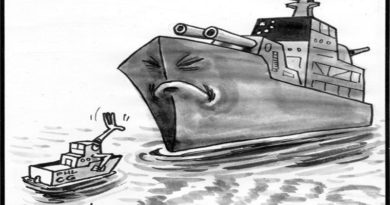Thinking Aloud: Wishes for a post-pandemic future
Thinking Aloud:
My parents, both born-and-bred Singaporeans, have never flown the national carrier.
Like many senior Singaporeans, they are frugal to a fault. They can afford the occasional trip abroad, but find it difficult to pay for an SQ ticket, given the significant price differences with other full service carriers.
Yet, they take quiet pride in the heights that our national carrier has soared to, as many Singaporeans do. It flies Singapore’s flag high, to places far and near.


SPACE RESERVE FOR ADVERTISEMENT.
So when Singapore Airlines (SIA) was hit hard by Covid-19, they felt the pain too. My father, who runs a small carpentry business, is suffering badly. But it is nothing like seeing a national icon fall.
Last month, SIA received a lifeline. The airline aims to raise $15 billion by asking investors to buy new shares as well as mandatory convertible bonds. Its biggest shareholder, Temasek, has committed to buying whatever shares and bonds that are not taken up.
This is on top of the Jobs Support Scheme which will offset 75 per cent of SIA’s wage costs until the end of the year (non-aviation companies get the same leg-up for April and May), saving the airline $400 million to $600 million, according to analysts’ estimates.


SPACE RESERVE FOR ADVERTISEMENT.
A slew of rebates and reliefs will put a lid on its other costs such as parking charges and rent.


SPACE RESERVE FOR ADVERTISEMENT.
All this means that SIA is in pole position to bounce back faster and stronger than most of its other rivals around the world when recovery comes.
It is clear why Singapore needed to move – and decisively – in bolstering the carrier. As Deputy Prime Minister Heng Swee Keat put it, SIA is “a strategic asset for Singapore”.
Even more direct government support for SIA may be in the offing.


SPACE RESERVE FOR ADVERTISEMENT.
He added: “Through the Government’s support for the aviation sector, and if necessary more direct support measures, we will make sure that SIA is able to come through this in good shape.”



SPACE RESERVE FOR ADVERTISEMENT.
A strong home carrier is essential to a strong airport hub. A strong airport hub is central to Singapore’s success story. They provide work to hundreds of thousands of people, contribute billions to the economy and burnish Singapore’s brand name.
It did not begin like this. SIA started life in 1972 disparagingly dubbed a “pirate” and a “parasite” by competitors for its audacity in giving passengers free earphones and alcohol. Back then, others were charging US$2 (about S$5.60 then) for the privilege of downing a beer at high altitudes.
With verve, innovation and no little support from the Government, SIA muscled its way to the top, in tandem with Singapore’s progress from Third World to First. It regularly bags the title of the World’s Best Airline.


SPACE RESERVE FOR ADVERTISEMENT.
Today, as SIA faces down the worst crisis in its history, the country is stepping up.
In ruminating on how Singapore’s and SIA’s destinies are intertwined, I also think about the older generation of Singaporeans. In their own way, as taxpayers and as cheerleaders, they have had bit parts to play in the rise of our national carrier.
So, here is a bit of an unusual suggestion for SIA: When this is all over, when people are picking themselves up, and when it is safe again to travel, give every Pioneer Generation Singaporean a chance to fly SQ, just once, in their lives.


SPACE RESERVE FOR ADVERTISEMENT.
How? Allow family members to buy vouchers for future flights for these seniors. In return, reward these advance payments with a hefty discount.
Better still, consider giving Pioneer Generation Singaporeans a ticket each, subject to a cap.
So that every Singaporean of a certain age can say: “When I flew Singapore Airlines that time…”


SPACE RESERVE FOR ADVERTISEMENT.
This may be derided as tokenism; it is less helpful than a straight-out $600 Solidarity Payment for all adult Singaporeans. Investors will baulk at it. It is administratively challenging to carry out. But it could pay off in terms of an even stronger emotional connection forged with those rooting for a national institution.
It is a change from the usual Singapore way of boosting morale and tiding people over bad times. It is certainly a change from the usual relationship between a listed company and its customers.
But then, the times are not usual. It is not business as usual.


SPACE RESERVE FOR ADVERTISEMENT.
AGENT OF CHANGE
If there is a silver lining to the pandemic, it is that it could prompt some soul-searching – and changes – in the way we live and our relationships with one another.
In an interview with my colleague Olivia Ho for an Insight feature on the pandemics that Singapore has seen over the past century, published last Sunday, cultural studies researcher Liew Kai Khiun said that pandemics should be seen “not just as angels of death, but also as agents of change”.
Already, discussions are under way “to reimagine the economies and societies of the post-pandemic future”.
I find that uplifting. Even as we grapple with what seems to be an unceasing stream of bad news – daily new cases in the thousands, deaths, weak links – we can find hope in a future that can be an improvement over a pre-Covid past.
One change that I would like to see in our post-pandemic future is how migrant workers in Singapore live and work.
What has been laid bare is the unsanitary and cramped dormitory conditions in which some of them have been living.


SPACE RESERVE FOR ADVERTISEMENT.
In a report on April 6, The Straits Times senior correspondent Joyce Lim wrote of fear among workers in S11 Dormitory @ Punggol of the virus spreading in their living quarters. They said they had not been given masks, described overflowing toilets and roach-infested rooms, and worried about how overcrowding means that no safe-distancing measures could be feasibly taken.
Since then, the authorities have taken firm steps to clean up the situation, while segregating those working in essential services.
And partially due to aggressive testing, the number of infected foreign workers here rose to nearly 10,000 in the past three weeks.
Today, the focus is on making sure that they are well cared for, while uninfected workers under lockdown have their daily needs looked after and their salaries paid.


SPACE RESERVE FOR ADVERTISEMENT.
But when the crisis is over, we will need to return to this issue: How do we ensure that migrant workers here are housed properly and decently?
In a Facebook post, Manpower Minister Josephine Teo said that it was not for want of trying.
“Each time we attempt to raise standards, employers yelp – these are added costs which they must eventually pass on. They ask MOM, ‘are people prepared to pay more?’ These workers are, after all, involved in delivering important services for Singaporeans, including construction.”
Assuming that these are indeed costs that must be passed on – the dormitory operators are known to chalk up a tidy profit; mainboard-listed operator Centurion Corporation, for instance, posted a 38 per cent rise in net profit to $73.1 million for its fourth quarter ending Dec 31 – this is a national conversation that we need to have.
Are Singaporeans willing to pay more for their HDB flats in return for migrant workers from India, Bangladesh and China living, say, six to a room instead of 12?
These workers also work in public infrastructure projects, from road works to MRT lines to desalination plants. Will we be happy to pay more for ERP, for our train fares, for our water, and ultimately in taxes?
The answer will have to be “yes”, if the images and accounts of how they had been living trouble us.
But this effort needs to go hand in hand with another push – for productivity, so that we reduce our reliance on foreign labour.


SPACE RESERVE FOR ADVERTISEMENT.
As of June last year, there were 981,000 foreign workers here on work permits. Some 284,300 of them are in construction.
The numbers have not budged much from five years ago (991,300 and 322,700 respectively), despite a high-profile national drive to increase productivity that began a decade ago.
In 2010, a high-powered Economic Strategies Committee chaired by then Finance Minister Tharman Shanmugaratnam said the country urgently needed to break out of its cycle of low productivity.
Companies need to harness technology and innovation to drive output. Sectors have to wean themselves off cheap foreign labour. Annual productivity growth must rise to 2 per cent to 3 per cent.
Mr Tharman said: “This is a major new phase in our economy, and the Government will want to be bold.”
Since then, though, despite a litany of measures – the latest being $19 million set aside to help small and medium-sized construction firms defray the costs of adopting digital solutions – Singapore’s productivity journey has progressed in fits and starts.
This year, productivity, measured as real value added per worker, fell by 0.8 per cent.
Anecdotally, in construction, despite a few poster boys adopting the latest technology to improve work processes, it is not clear that there have been substantive changes across the industry.
For instance, scenes of some 10 construction workers at a minor road works site – with four just to direct traffic – remain commonplace.
Whatever happened in recent years, in a post-Covid era, productivity has to be a key priority, given how our reliance on foreign workers has been shown up to be a key vulnerability.


SPACE RESERVE FOR ADVERTISEMENT.
A CLEANER SINGAPORE
One last wish for a post-pandemic future: change in Singaporeans’ personal hygiene habits.
Hopefully, Covid-19 will be to Singapore what Sars was to Hong Kong, in terms of a wake-up call.
In 2003, the severe acute respiratory syndrome outbreak swept through the territory. It killed 299 people and changed the lifestyle habits of the 7.5 million residents there.
Having lived there for four years from 2012 to 2016, I saw how seriously Hong Kongers take hygiene on a daily basis, from the way they don their masks once unwell, to the care they take in using their public toilets – in markets, next to temples, along hiking trails.
This culture has been cited as a reason for why the city has achieved some success in beating back the coronavirus. Schools were promptly closed since the Chinese New Year week in January and people were mostly quick to adhere to social distancing rules – not just to their letter but also to their spirit.
In the past two weeks, the daily rise in infections in Hong Kong has stayed in the single digits, and the city is now preparing to ease up on some restrictions.


SPACE RESERVE FOR ADVERTISEMENT.
In Singapore, with more lackadaisical attitudes towards hygiene especially in the early days of the outbreak, there was perhaps not that same implicit trust in fellow countrymen – the assurance that we are taking care of one another, such as by wearing masks when ill or avoiding going out.
This, hopefully, is changing as the pandemic wears on, and new norms take hold.
It has now been 20 days since Singapore entered the circuit breaker period.
These unprecedented times have wrought changes in relationships, as parents and children, bosses and workers and customers, government and citizens navigate new terrains.
When we emerge from it, what kind of Singapore will greet us?


SPACE RESERVE FOR ADVERTISEMENT.











